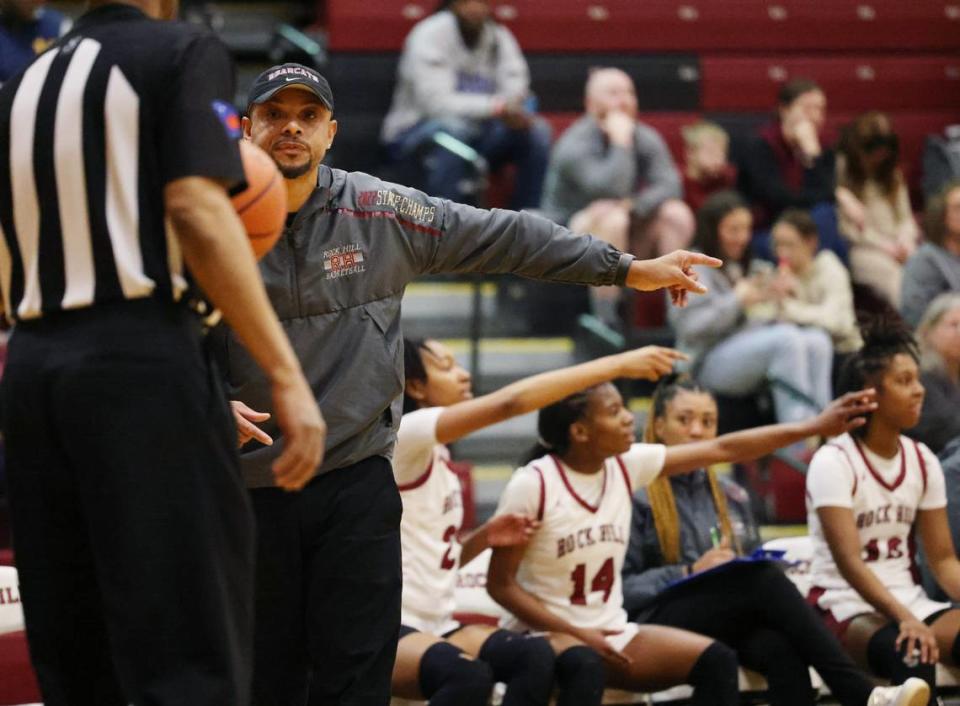Class 5A’s playoffs make the switch to two divisions in SC. ‘It just kinda made sense.’
The South Carolina High School League voted 12-1 this week 23 to split Class 5A into two divisions for the upcoming realignment period.
The split will only affect the playoffs by breaking up the 5A schools in Division 1 (largest schools) and Division 2 (remaining schools) into brackets.
The will be crowning two 5A state champions for every sport for the 2024-2026 school years.
Regular-season play will not be affected by the new format, which comes after realignment increased the number of 5A schools from 36 to 54 starting next school year. The state’s 26 largest schools will play in Division I; the remaining 28 will play in Division II.
In larger postseason tournaments like football and basketball, there will be 48 playoff teams: 24 for each division from upper and lower state teams, divided equally.
Catawba Ridge athletic director Richard Lewis, who is also a member of the SCHSL playoff committee, said a leading factor for the split was the looming possibility of creating a 6A classification.
However, to create a Class 6A would require an amendment to the SCHSL constitution and further planning would be needed. Splitting the postseason into two divisions was a quicker and more sensible alternative.
“When you look at the five classifications, 5A is going to be the largest classification,” Lewis said. “When you look at the split, particularly for Catawba Ridge, we were the last one put in 5A, and we’re considerably smaller of a school than the top end where there might be 3,000 in one high school and we’re sitting at 1,670. It’s almost double the size, and that’s a competitive imbalance. Being able to split it into a bigger and a smaller division, it just kind of made sense.”
York and Lancaster counties will combine to form the seven-team Region 3-5A: Catawba Ridge, Clover, Fort Mill, Indian Land, Nation Ford, Northwestern and Rock Hill.
Clover and Rock Hill will play in the Division I postseason bracket, while the others will play in Division II.
How will the playoffs work?
Class 5A is comprised of eight regions of six to eight schools.
Regions with six schools will have three automatic qualifiers to the postseason, while regions with seven or eight schools will have four automatic bids.
That format is not new, but what is new is the way the qualifying teams will be seeded.
Teams will be seeded using MaxPreps RPI formula, an algorithm that factors in winning percentage for teams and opponents. RPI is used in other states, such as North Carolina and Ohio, but the formula is not always the same from state to state.
Lewis said that South Carolina’s RPI formula will be 50% of a team’s winning percentage; 40% of a their opponents’ winning percentage; and 10% of the opponents of their opponents’ win percentage.
All of the region winners will be seeded using RPI first, then all of the second-place finishers, etc. Fourth-place finishers in a region with four automatic qualifying spots will be seeded ahead of fourth-place finishers in a region with only three automatic qualifiers.
“I think they did a good job of balancing the importance of everyone of finishing high in your region and playing tough teams,” Northwestern football coach Page Wofford said. “You don’t want to go by record alone or winning percentage because nobody would schedule Northwestern. I have trouble finding games, and I’m not the only one...There’s teams in the area that have trouble finding games, and that was the nature of the beast.”

The playoff committee also implemented a “leapfrog” rule for the 2024-25 school year.
If Indian Land finishes ahead of Nation Ford in the region standings, but Nation Ford finished with a higher RPI, the “leapfrog” rule states that Nation Ford can’t be seeded ahead of Indian Land. However, Nation Ford could be seeded ahead of a non-automatic qualifying school from another region if Nation Ford has a higher RPI.
Another change to the playoff format is that positioning and hosting is no longer predetermined.
In years past, teams knew months in advance where their position in the region would place them in the bracket. Now, with the use of RPI, schools won’t know who their playoff opponent is until after the final game of the regular season. This also opens up a possibility for region teams to face each other in the first round of the playoffs.
Rock Hill girls’ basketball coach Kenny Orr said that this change is good because you’re not running into the same team or group of teams every postseason.

“If you think about, Woodmont would have to play us every year in the second round,” Orr said. “And they were always good. There’s no reason that game couldn’t be a (upper state final) or a third-round game instead of a second-round or first-round game. Being able to use strength of schedule and quality opponents and now you’re getting seeded, I like that better.”
RPI will be the main tiebreaker between schools, but Lewis said that all current region tiebreakers will still be in play if two teams are tied in region standing and RPI.
It’s not a perfect playoff format
The current proposed playoff format guarantees first-round byes for each region winner. However, that still leaves eight additional slots for first-round byes that need to be filled in order to make the numbers work, meaning that the second-place region finishers will also likely receive first-round byes as well.
However, if you play in a region with an odd number of teams, like Region 3-5A, this proposed benefit could actually put a school’s football team in a rather precarious spot.
“If you look at Rock Hill High, they have Week 10 (the final week of the regular season) already off,” Wofford said. “If they win the region, they’re going to have off Week 10 and Week 11, the first round of the playoffs, and they’ll go three weeks between games.... That’s a lot. That’s a lot for a high school kid. That’s a lot for a high school staff.”
In other sports, the bye for region winners is a more welcome gift.
“Why not reward the teams that actually had a good finish?” Orr said. “Sumter had that happen to them this year because there wasn’t an at-large team that wanted to play Sumter. So Sumter had a first-round bye that not a lot of people realized. Sumter only had to win four (playoff games) to (win the state championship), so I feel like whoever you are, whatever it is, if you’re one of the better teams, you should be rewarded, right? To me, your body of work should stand for something.”
Orr, however, is not the biggest fan of the new playoff format.
He feels like it takes away from the sense of achievement of winning a 5A state championship — but not the only one.
“Now you get to this old limbo of ‘you get a trophy, you get a trophy’, everybody’s getting something,” Orr said. “The part of being champion is that you have to win. What if the NCAA breaks (the NCAA Tournament) into two? One has the blue bloods, then you have the other teams. Is one state championship bigger than the other one?”
“To me, the idea of the whole thing is that you’re the best in that classification,” Orr said.

